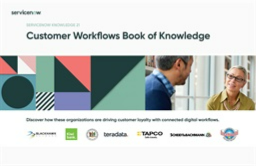Customer Workflows Book of Knowledge
The biggest business story of the last year was the impact of COVID-19 on the way we work and live. What it showed is that change can happen in an instant and without warning. So, it's critical to be able to adapt and rise to the challenge.
Throughout this book you'll see stories from organizations who tackled complex challenges with workflows. While the problems are different, they all pushed forward and took the lead on their own digital transformation and, with the help of ServiceNow, unlocked impressive results.
Discover how these organizations are driving customer loyalty with connected digital workflows. These quick-read summaries of their Knowledge 2020 breakout presentations offer insights into innovative approaches for unified customer engagement, field service, and service operations.
Read More
By submitting this form you agree to ServiceNow contacting you with marketing-related emails or by telephone. You may unsubscribe at any time. ServiceNow web sites and communications are subject to their Privacy Notice.
By requesting this resource you agree to our terms of use. All data is protected by our Privacy Notice. If you have any further questions please email dataprotection@techpublishhub.com
Related Categories: AIM, Analytics, Applications, Cloud, Collaboration, Digital transformation, Email, ERP, IOT, ITSM, Mobility, Network, SAN, Service Management, ServiceNow, Storage, Telecommunications


More resources from ServiceNow

5 steps to harness the power of the organizat...
Experiences are more than just touchpoints—how customers achieve their desired outcomes is what matters.
Read this guide for a five-step ro...

How to Keep People at the Center of Hyperauto...
The disruptive impact that COVID has had on enterprises today has raised the stakes on business process transformation. As a result, many organizat...

ServiceNow + Vonage: The Perfect Combo
Video Overview of Vonage Contact Center and ServiceNow - Vonage Contact Center (VCC) for ServiceNow integrates Vonage's contact center solution wit...